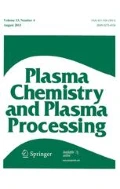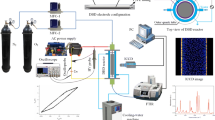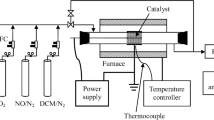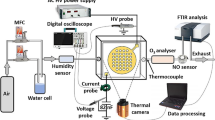Abstract
This study presented a quantitative evaluation of the performance of a low power miniaturized SDBD source for the production of ozone and nitrogen oxides as benchmarks of long-lived RONS. The effects of varying oxygen and humidity on the trend of the production efficiency are investigated. The oxygen content and the humidity had no noticeable effect on the total power consumed, but their level in the feeding gas has a strong impact on the production of NxOy. It is found also that there is an optimum level of the oxygen content and the humidity for the production of NO2 and N2O. The analysis of the results indicated that the nitrogen excited species, especially \({\text{N}}_{2 } \left( {A^{3} \varSigma_{u}^{ + } } \right)\) and N(2D) play vital roles in the production of the nitrogen oxides, particularly the NO, which considered as the main source for the other NxOy in the present system. Interestingly, it is found that the humidity has a positive effect on the NO2 production, while it has a negative effect on the N2O and O3, which implied that the present SDBD is a strong oxidizer for the formed NO. The rise in the gas temperature in the present SDBD was negligible and has no effect on the production of nitrogen oxides, while the temperature of the plasma channel might affect the RONS production efficiency. Investigating the production mechanisms and the energy efficiency, of the formed nitrogen oxides, unravels for the first time the performance of the SDBD for nitrogen fixation.














Similar content being viewed by others
References
Morgan NN (2009) Atmospheric pressure dielectric barrier discharge chemical and biological applications. Int J Phys Sci 4:885–892
Kim H-H (2004) Nonthermal plasma processing for air-pollution control: a historical Rreview, current issues, and future prospects. Plasma Process Polym 1:91–110
Brandenburg R (2017) Dielectric barrier discharges: progress on plasma sources and on the understanding of regimes and single filaments. Plasma Sources Sci Technol 26:053001
Benard N, Moreau E (2014) Electrical and mechanical characteristics of surface AC dielectric barrier discharge plasma actuators applied to airflow control. Exp Fluids vol:55
Abdelaziz A, Ishijima T, Seto T, Osawa N, Wedaa H, Otani Y (2016) Characterization of surface dielectric barrier discharge influenced by intermediate frequency for ozone production. Plasma Sources Sci Technol 25:035012
Abdelaziz A, Seto T, Abdel-Salam M, Otani Y (2012) Performance of a surface dielectric barrier discharge based reactor for destruction of naphthalene in an air stream. J Phys D Appl Phys 45:115201
Shimizu K, Yamada M, Kanamori M, Blajan M (2010) Basic study of bacteria inactivation at low discharge voltage by using microplasmas. IEEE Trans Ind Appl 46:641–649
Malik MA, Kolb JF, Sun Y, Schoenbach KH (2011) Comparative study of NO removal in surface-plasma and volume-plasma reactors based on pulsed corona discharges. J Hazard Mater 197:220–228
Malik MA, Hughes D, Heller R, Schoenbach KH (2015) Surface plasmas versus volume plasma: energy deposition and ozone generation in air and oxygen. Plasma Chem Plasma Process 35:697–704
Masuda S, Akutsu K, Kuroda M, Awatsu Y, Shibuya Y (1988) A ceramic-based ozonizer using high-frequency discharge. IEEE Trans Ind Appl 24:223–232
McAdams R (2001) Prospects for non-thermal atmospheric plasmas for pollution abatement. J Phys D Appl Phys 34:2810–2821
Pavlovich MJ, Clark DS, Graves DB (2014) Quantification of air plasma chemistry for surface disinfection. Plasma Sources Sci Technol 23:065036
Jeon J, Klaempfl TG, Zimmermann JL, Morfill GE, Shimizu T (2014) Sporicidal properties from surface micro-discharge plasma under different plasma conditions at different humidities. New J Phys 16:103007
Maisch T, Shimizu T, Li YF, Heinlin J, Karrer S, Morfill G, Zimmermann JL (2012) Decolonisation of MRSA, S. aureus and E. coli by cold-atmospheric plasma using a porcine skin model in vitro. PLoS ONE 7:e34610
Morfill GE, Shimizu T, Steffes B, Schmidt HU (2009) Nosocomial infections—a new approach towards preventive medicine using plasmas. New J Phys 11:115019
Jeon J, Rosentreter TM, Li Y, Isbary G, Thomas HM, Zimmermann JL et al (2014) Bactericidal agents produced by surface micro-discharge (SMD) plasma by controlling gas compositions. Plasma Process Polym 11:426–436
Koga K, Thapanut S, Amano T, Seo H, Itagaki N, Hayashi N et al (2016) Simple method of improving harvest by nonthermal air plasma irradiation of seeds of Arabidopsis thaliana (L.). Appl Phys Express 9:016201
Shimizu T, Sakiyama Y, Graves DB, Zimmermann JL, Morfill GE (2012) The dynamics of ozone generation and mode transition in air surface micro-discharge plasma at atmospheric pressure. New J Phys 14:103028
Li S, Ma X, Jiang Y, Cao X (2014) Acetamiprid removal in wastewater by the low-temperature plasma using dielectric barrier discharge. Ecotoxicol Environ Saf 106:146–153
Pekárek S (2012) Experimental study of surface dielectric barrier discharge in air and its ozone production. J Phys D Appl Phys 45:075201
Pekárek S (2013) Asymmetric properties and ozone production of surface dielectric barrier discharge with different electrode configurations. Eur Phys J D 67:94
Malik MA, Schoenbach KH, Heller R (2014) Coupled surface dielectric barrier discharge reactor-ozone synthesis and nitric oxide conversion from air. Chem Eng J 256:222–229
Mastanaiah N, Banerjee P, Johnson JA, Roy S (2013) Examining the role of ozone in surface plasma sterilization using dielectric barrier discharge (DBD) plasma. Plasma Process Polym 10:1120–1133
Pavlovich MJ, Chang H-W, Sakiyama Y, Clark DS, Graves DB (2013) Ozone correlates with antibacterial effects from indirect air dielectric barrier discharge treatment of water. J Phys D Appl Phys 46:145202
Jodzis S, Smolinski T, Sowka P et al (2011) Ozone synthesis under surface discharges in oxygen: application of a concentric actuator. IEEE Trans Plasma Sci 39:1055–1060
Schnabel U, Andrasch M, Weltmann K-D, Ehlbeck J (2014) Inactivation of vegetative microorganisms and bacillus atrophaeus endospores by reactive nitrogen species (RNS). Plasma Processes Polym 11:110–116
Sakai S, Matsuda M, Wang D, Namihira T, Akiyama H, Okamoto K et al (2009) Nitric oxide generator based on pulsed arc discharge. Acta Phys Pol A 115:1104–1106
Douat C, Hübner S, Engeln R, Benedikt J (2016) Production of nitric/nitrous oxide by an atmospheric pressure plasma jet. Plasma Sources Sci Technol 25:025027
Oehmigen K, Hähnel M, Brandenburg R, Wilke C, Weltmann KD, von Woedtke T (2010) The role of acidification for antimicrobial activity of atmospheric pressure plasma in liquids. Plasma Process Polym 7:250–257
Chen CW, Lee HM, Chang MB (2008) Inactivation of aquatic microorganisms by low-frequency AC discharges. IEEE Trans Plasma Sci 36:215–219
Graves DB (2012) The emerging role of reactive oxygen and nitrogen species in redox biology and some implications for plasma applications to medicine and biology. J Phys D Appl Phys 45:263001
Tian W, Kushner MJ (2014) Atmospheric pressure dielectric barrier discharges interacting with liquid covered tissue. J Phys D Appl Phys 47:165201
Patil BS, Wang Q, Hessel V, Lang J (2015) Plasma N2-fixation: 1900–2014. Catal Today 256:49–66
Simek M, Pekarek S, Prukner V (2012) Ozone production using a power modulated surface dielectric barrier discharge in dry synthetic air. Plasma Chem Plasma Process 32:743–754
Hong D, Rabat H, Bauchire JM, Chang MB (2014) Measurement of ozone production in non-thermal plasma actuator using surface dielectric barrier discharge. Plasma Chem Plasma Process 34:887–897
Herron JT (2001) Modeling studies of the formation and destruction of NO in pulsed barrier discharges in nitrogen and air. Plasma Chem Plasma Process 21:581–610
Atkinson R, Baulch DL, Cox RA, Crowley JN, Hampson RF, Hynes RG, Jenkin ME, Rossi MJ, Troe J (2004) Evaluated kinetic and photochemical data for atmospheric chemistry: volume I—gas phase reactions of Ox, HOx, NOx and SOx species. Atoms. Chem. Phys. 4:1461–1738
Teodoru S, Kusano Y, Bogaerts A (2012) The effect of O2 in a humid O2/N2/NOx gas mixture on NOx and N2O remediation by an atmospheric pressure dielectric barrier discharge. Plasma Process Polym 9:652–689
Tálský A, Štec O, Pazderka M, Kudrle V (2017) Kinetic study of atmospheric pressure nitrogen plasma afterglow using quantitative electron spin resonance spectroscopy. J Spectrosc 2017:1–10
Forte M, Jolibois J, Pons J, Moreau E, Touchard G, Cazalens M (2007) Optimization of a dielectric barrier discharge actuator by stationary and non-stationary measurements of the induced flow velocity: application to airflow control. Exp Fluids 43:917–928
Kotsonis M (2015) Diagnostics for characterisation of plasma actuators. Meas Sci Technol 26:092001
Abdelaziz A, Seto T, Abdel-Salam M, Otani Y (2014) Influence of N2/O2 mixtures on decomposition of naphthalene in surface dielectric barrier discharge based reactor. Plasma Chem Plasma Process 34:1371–1385
Font GI, Enloe CL, Newcomb JY, Teague AL, Vasso AR, McLaughlin TE (2011) Effects of oxygen content on dielectric behavior barrier discharge plasma actuator behavior. AIAA J 49:1366–1373
Koeta O, Blin-Simiand N, Pasquiers S, Jordan F, Bary A (2012) Effect of oxygen percentage on the removal of acetaldehyde by dielectric barrier discharge. Int J Plasma Environ Sci Technol 6:227–232
Pan J, Tan Z, Liu Y, Pan G, Wang X (2015) Effects of oxygen concentration on atmospheric-pressure pulsed dielectric barrier discharges in argon/oxygen mixture. Phys Plasmas 22:093515
Guo Y, Liao X, Fu M, Huang H, Ye D (2015) Toluene decomposition performance and NOx by-product formation during a DBD-catalyst process. J Environ Sci (China) 28:187–194
Cooray V, Rahman M (2005) Efficiencies for production of NOx and O3 by streamer discharges in air at atmospheric pressure. J Electrostat 63:977–983
Kogelschatz U, Baessler P (1987) Determination of nitrous oxide and dinitrogen pentoxide concentrations in the output of air-fed ozone generators of high power density. Ozone Sci Eng 9:195–206
Kogelschatz U, Eliasson B, Hirth M (1988) Ozone generation from oxygen and air-discharge physics and reaction mechanisms. Ozone Sci Eng 10:367–378
Marode E, Djermoune D, Dessante P, Deniset C, Ségur P, Bastien F, Bourdon A, Laux C (2009) Physics and applications of atmospheric non-thermal air plasma with reference to environment. Plasma Phys Control Fusion 51:124002
Gherardi N, Osawa N, Tsuji T, Ogiso R, Yoshioka Y, Hoder T (2017) Effect of nitrogen addition to ozone generation characteristics by diffuse and filamentary dielectric barrier discharges at atmospheric pressure. Eur Phys J Appl Phys 78:20804
Hensel K, Machala Z, Tardiveau P (2009) Capillary microplasmas for ozone generation. Eur Phys J Appl Phys 47:22813–22818
Whitehead JC (2010) Plasma catalysis: a solution for environmental problems. Pure Appl Chem. 82:1329–1336
Heintze M, Pietruszka B (2004) Plasma catalytic conversion of methane into syngas: the combined effect of discharge activation and catalysis. Catal Today 89:21–25
Yan K, Kanazawa S, Ohkubo T, Nomoto Y (1999) Oxidation and reduction processes during NOx removal with corona-induced nonthermal plasma. Plasma Chem Plasma Process 19:421–443
Mok YS, Lee H-J (2006) Removal of sulfur dioxide and nitrogen oxides by using ozone injection and absorption–reduction technique. Fuel Process Technol 87:591–597
Jodzis S (2011) Application of technical kinetics for macroscopic analysis of ozone synthesis process. Ind Eng Chem Res 50:6053–6060
Kong MG, Kroesen G, Morfill G, Nosenko T, Shimizu T, van Dijk J, Zimmermann JL (2009) Plasma medicine: an introductory review. New J Phys 11:115012
Jodzis S (2002) Effect of silica packing on ozone synthesis from oxygen–nitrogen mixtures. Ozone Sci Eng 25:63–72
Fan X, Kang S, Li J, Zhu T (2018) Conversion of dilute nitrous oxide (N2O) in N2 and N2–O2 mixtures by plasma and plasma-catalytic processes. RSC Adv 8:26998–27007
Penetrante BM, Bardsley JN, Hsiao MC (1997) Kinetic analysis of non-thermal plasmas used for pollution control. Jpn J Appl Phys 36:5007–5017
Yin S-E, Sun B-M, Gao X-D, Xiao H-P (2009) The effect of oxygen and water vapor on nitric oxide conversion with a dielectric barrier discharge reactor. Plasma Chem Plasma Process 29:421–431
Trinh Q-H, Kim SH, Mok YS (2016) Removal of dilute nitrous oxide from gas streams using a cyclic zeolite adsorption–plasma decomposition process. Chem Eng J 302:12–22
Fouad L, Elhazek S (1995) Effect of humidity on positive corona discharge in a three electrode system. J Electrostat 35:21–30
Fridman A (ed) (2008) Plasma chemistry. Cambridge University Press, New York
Abdelaziz AA, Ishijima T, Seto T (2018) Humidity effects on surface dielectric barrier discharge for gaseous naphthalene decomposition. Phys Plasmas 25:043512
Hähnel M, von Woedtke T, Weltmann K-D (2010) Influence of the air humidity on the reduction of bacillus spores in a defined environment at atmospheric pressure using a dielectric barrier surface discharge. Plasma Process Polym 7:244–249
Chiper A, Simiand N, Jorand F, Pasquiers S, Popa G, Postel C (2006) Influence of water vapour on acetaldehyde removal efficiency by DBD. J Optoelectron Adv Mater 8:208–211
Sivachandiran L, Khacef A (2016) In situ and ex situ NO oxidation assisted by sub-microsecond pulsed multi-pin-to-plane corona discharge: the effect of pin density. RSC Adv 6:29983–29995
Tang X, Wang J, Yi H, Zhao S, Gao F, Chu C (2018) Nitrogen fixation and NO conversion using dielectric barrier discharge reactor: identification and evolution of products. Plasma Chem Plasma Process 38:485–501
Ono R, Teramoto Y, Oda T (2010) Effect of humidity on gas temperature in the afterglow of pulsed positive corona discharge. Plasma Sources Sci Technol 19:015009
McKay K, Liu DX, Rong MZ, Iza F, Kong MG (2012) Generation and loss of reactive oxygen species in low-temperature atmospheric-pressure RF He + O2 + H2O plasmas. J Phys D Appl Phys 45:172001
Lukes P, Clupek M, Babicky V, Janda V, Sunka P (2005) Generation of ozone by pulsed corona discharge over water surface in hybrid gas–liquid electrical discharge reactor. J Phys D Appl Phys 38:409–416
Ma T, Zhao Q, Liu J, Zhong F (2016) Study of humidity effect on benzene decomposition by the dielectric barrier discharge nonthermal plasma reactor. Plasma Sci Technol 18:686–692
Matsui K, Ikenaga N, Sakudo N (2015) Effects of humidity on sterilization of Geobacillus stearothermophilus spores with plasma-excited neutral gas. Jpn J Appl Phys 54:p. 06GD02
Junhong C, Pengxiang W (2005) Effect of relative humidity on electron distribution and ozone production by DC coronas in air. IEEE Trans Plasma Sci 33:808–812
Herron JT, Green DS (2001) Chemical kinetics database and predictive schemes for nonthermal humid air plasma chemistry. Part II. Neutral species reactions. Plasma Chem Plasma Process 21:459–481
Gray D, Lissi E, Heicklen J (1972) Reaction of hydrogen peroxide with nitrogen dioxide and nitric oxide. J Phys Chem 76:1919–1924
Mok YS, Koh DJ, Shin DN, Kim KT (2004) Reduction of nitrogen oxides from simulated exhaust gas by using plasma–catalytic process. Fuel Process Technol 86:303–317
Acknowledgements
This work was partially supported by the Chubu foundation fellowship program (2015). Dr. Ayman A. Abdelaziz thanks Chubu foundation for supporting his fellowship research at the Kanazawa University. Thanks are due to Mr. Takafumi Tsuji and Mr. Shingo Hayamizu for the assistance offered during the measurements of the nitrogen oxides by the FTIR.
Author information
Authors and Affiliations
Corresponding author
Rights and permissions
About this article
Cite this article
Abdelaziz, A.A., Ishijima, T., Osawa, N. et al. Quantitative Analysis of Ozone and Nitrogen Oxides Produced by a Low Power Miniaturized Surface Dielectric Barrier Discharge: Effect of Oxygen Content and Humidity Level. Plasma Chem Plasma Process 39, 165–185 (2019). https://doi.org/10.1007/s11090-018-9942-y
Received:
Accepted:
Published:
Issue Date:
DOI: https://doi.org/10.1007/s11090-018-9942-y




